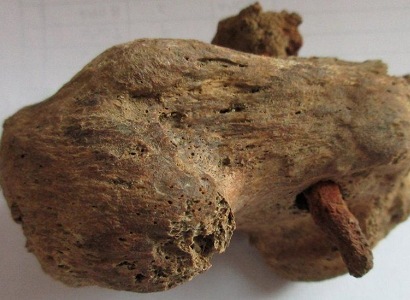The face of the crucified slave
Publish date 27-03-2024
 In 2017, a Roman-era cemetery was discovered in Cambridgeshire in which, between the 3rd and 4th centuries. AD, 40 adults and 5 children had been buried. All individuals bore on their bones the signs of a difficult life spent between poverty, hard work and illness. One grave in particular has attracted the attention of scholars: a skeleton belonging to a male of around 25-35 years old had a long iron nail stuck in his heel. This is one of the very few archaeological evidences of the crucifixion.
In 2017, a Roman-era cemetery was discovered in Cambridgeshire in which, between the 3rd and 4th centuries. AD, 40 adults and 5 children had been buried. All individuals bore on their bones the signs of a difficult life spent between poverty, hard work and illness. One grave in particular has attracted the attention of scholars: a skeleton belonging to a male of around 25-35 years old had a long iron nail stuck in his heel. This is one of the very few archaeological evidences of the crucifixion.
Although, according to historical sources, it was a common punishment in the Roman world, the condemned were probably usually blocked with ropes rather than the more expensive nails. These could be removed before burial, to be reused or worn as amulets. Furthermore, the condemned were often slaves, who were not buried together with the rest of the community.
In this case the tomb was part of the village cemetery and the body had been placed inside a wooden coffin, as demonstrated by the 15 nails found around him. However, he was probably a slave: osteo-archaeological analyzes demonstrate that he had been kept chained to a wall for a long time. Historically, crucifixion was prohibited for free citizens with the edict of Constantine in 337 AD, but it remained possible for slaves and for particularly serious crimes such as treason.
All this data, along with DNA analyses were given to forensic artist Joe Mullins, who creates reconstructions for law enforcement.
The artist used a computed tomography (CT scan) of the remains and software to create the structure of the face, to which he then added muscles, skin, beard and hair.
Now we can look at the face of the crucified individual, restoring humanity and dignity to this person who died 1600 years ago.
Agnese Picco
NP February 2024







